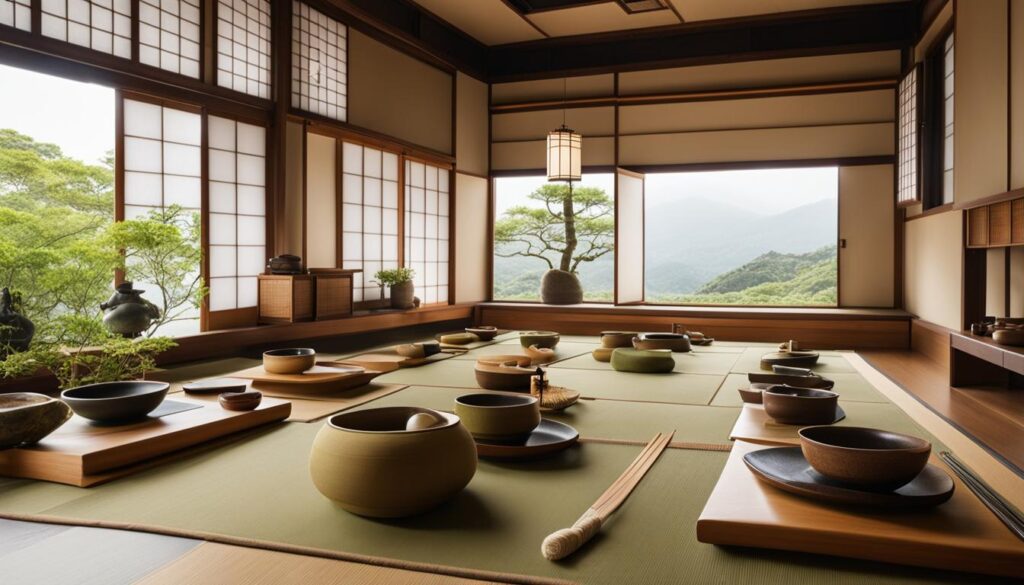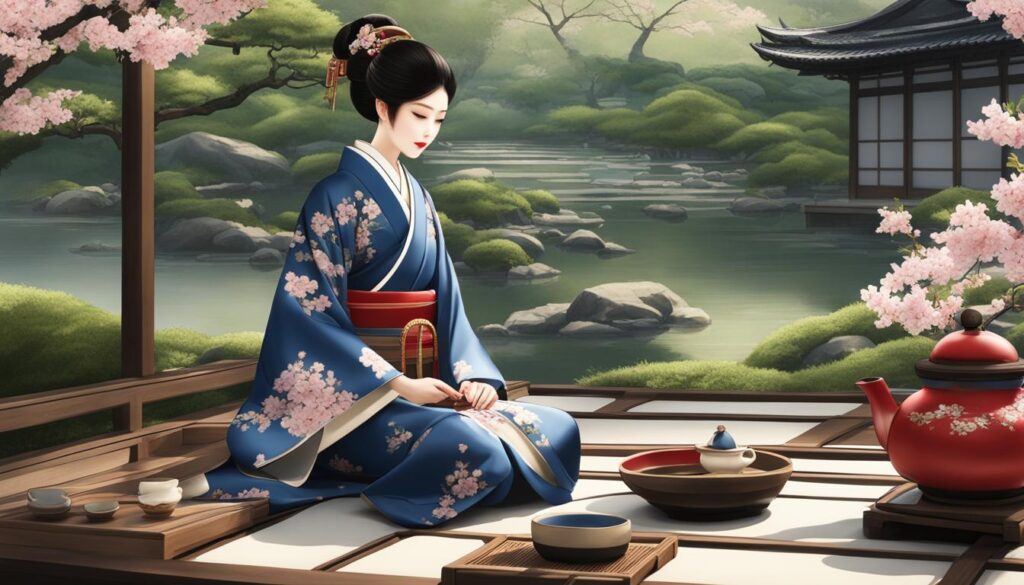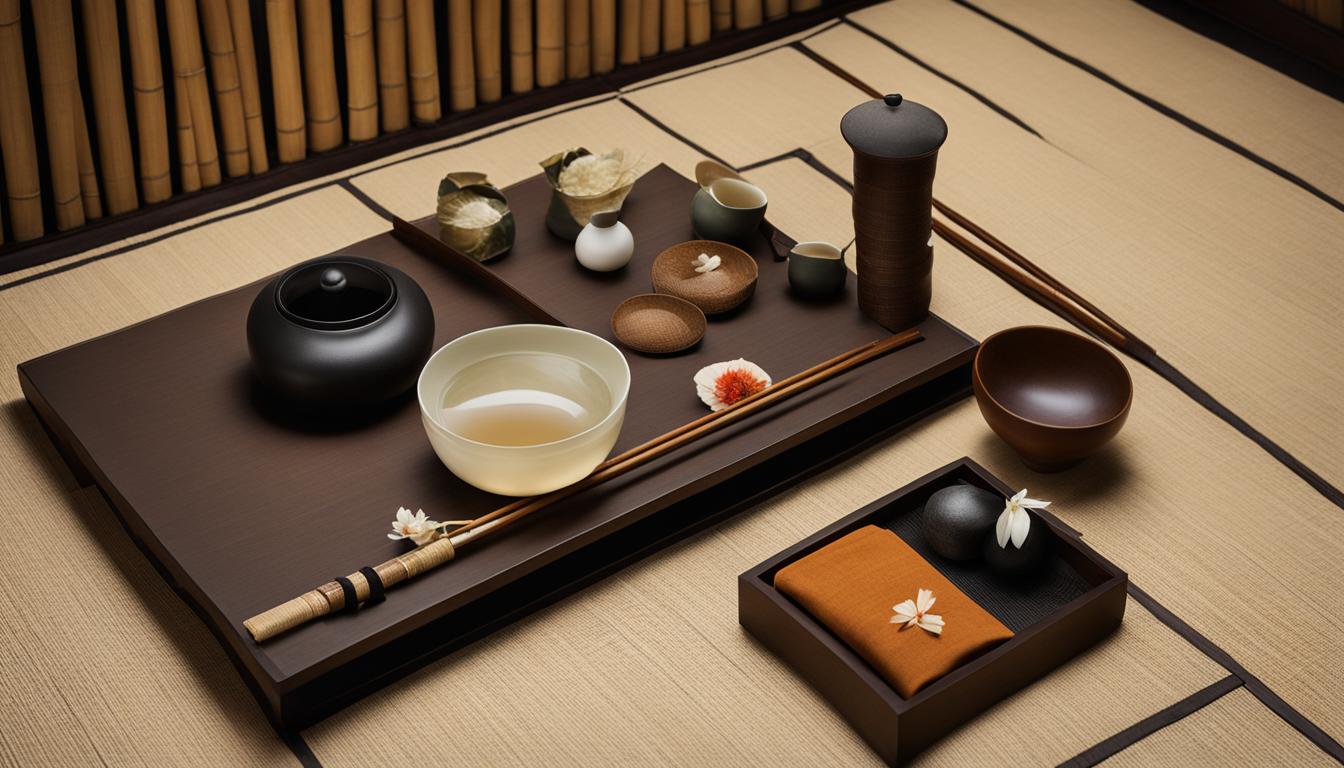Welcome to our complete guide on traditional tea ceremony attire and accessories. The tea ceremony is a timeless tradition that requires the appropriate clothing and fashion accessories to honor the culture and show respect for the tradition. Whether you’re attending a Chinese or Japanese tea ceremony, we’ve got you covered with all the information you need to know about tea ceremony clothing, including kimono styles, traditional attire, and fashion accessories.
Traditional tea ceremony attire varies depending on the culture and country. In Chinese tea ceremonies, the bride often wears a red cheongsam dress, symbolizing luck and happiness. For Japanese tea ceremonies, brides and grooms typically wear different styles of kimonos, such as the furisode or montsuki. Accessories like tea ceremony fans, hair ornaments, and traditional footwear complete the ensemble.
It’s important to understand the dress code guidelines of the specific tea ceremony you are attending to ensure you dress appropriately and honor the tradition. Join us as we delve into the details of tea ceremony attire and accessories, providing you with insights, tips, and fashion inspiration.
Key Takeaways:
- Traditional tea ceremony attire includes kimono styles and cultural-specific garments.
- Chinese tea ceremony attire often features a red cheongsam dress.
- Japanese tea ceremony attire typically involves wearing different types of kimonos.
- Tea ceremony fashion accessories, such as fans and hair ornaments, add elegance to the outfit.
- Respecting the tea ceremony dress code is essential to honor the tradition.
Traditional Tea Ceremony Attire for Chinese Tea Ceremony
When it comes to traditional tea ceremony attire for Chinese tea ceremonies, the iconic red cheongsam dress with a mandarin collar is the go-to choice for the bride. This dress not only symbolizes luck, happiness, and prosperity but also adds a touch of elegance to the overall look. The bride can opt for a floor-length red cheongsam dress or a shorter version depending on her preference and the formality of the ceremony.
For the groom, a simple and classic tuxedo can be a suitable choice. However, for those who wish to embrace the traditional attire, they can choose a robe or garment that complements the bride’s cheongsam. This way, the couple can harmonize their outfits while still paying homage to Chinese tea ceremony traditions.
In terms of accessories, tea ceremony fans and hair ornaments play a significant role in enhancing the attire. Adding a beautifully designed tea ceremony fan not only completes the look but also provides a functional accessory for the bride and groom during the ceremony. Hair ornaments such as decorative hairpins or elaborate hair accessories can be incorporated to add a touch of elegance and cultural significance.
| Traditional Tea Ceremony Attire for Chinese Tea Ceremony | Description |
|---|---|
| Bride’s Attire | Red cheongsam dress with a mandarin collar |
| Groom’s Attire | Simple tuxedo or traditional robe/garment |
| Accessories | Tea ceremony fan and hair ornaments |
Chinese Tea Ceremony Outfit Ideas
For those looking for Chinese tea ceremony outfit ideas, here are some options to consider:
- Modern Twist: Combine traditional elements with contemporary fashion by opting for a cheongsam-inspired dress in a non-traditional color or pattern.
- Cultural Fusion: Incorporate elements from both the bride’s and groom’s heritage by blending traditional Chinese attire with elements from another culture.
- Vintage Charm: Explore vintage shops or online platforms to find unique and authentic cheongsam dresses from different eras.
- Customized Design: Work with a skilled tailor to create a personalized cheongsam dress that reflects your personal style while still honoring the tea ceremony tradition.
“The red cheongsam dress is not only a beautiful choice for a Chinese tea ceremony, but it also carries deep cultural significance. It symbolizes luck, happiness, and prosperity, making it the perfect attire for such a joyous occasion.” – Tea Ceremony Fashion Expert
Traditional Tea Ceremony Attire for Japanese Tea Ceremony
When it comes to the Japanese tea ceremony, dressing in traditional attire is an essential part of the experience. The outfit worn by both the bride and groom reflects the rich cultural heritage of Japan and adds to the beauty and authenticity of the ceremony. Let’s explore some outfit ideas for the Japanese tea ceremony and the significance of the tea ceremony kimono styles.
Tea Ceremony Kimono Styles
The kimono is the centerpiece of traditional Japanese attire and plays a significant role in the tea ceremony. There are various styles of kimonos that can be worn, depending on the formality of the tea ceremony and the individual’s personal preference. The bride may choose to wear a furisode, which is a long-sleeved kimono that symbolizes youth and unmarried status. Alternatively, she may opt for an uchikake, which is a heavily embroidered outer kimono typically worn over a more subdued kimono. The groom can choose a montsuki, a formal kimono adorned with family crests, or a hakama and haori ensemble, which is a more casual yet sophisticated option. These kimono styles add grace and elegance to the tea ceremony.
Cultural Attire in Tea Ceremonies
The attire worn in the Japanese tea ceremony is deeply rooted in Japanese culture and traditions. The choice of fabric, color, and pattern of the kimono is often influenced by the season and the formality of the ceremony. For example, lighter fabrics and pastel colors are typically worn in spring, while richer fabrics and darker colors are preferred in winter. The tea ceremony attire reflects the reverence and respect for nature and the changing seasons, which are integral to Japanese culture. By dressing in traditional attire, participants honor the legacy of the tea ceremony and pay homage to Japanese customs.

Tea Ceremony Fashion Accessories
In addition to the traditional attire, there are various fashion accessories that can complement the tea ceremony outfit. These accessories not only add a touch of elegance but also showcase individual style and creativity. From tea ceremony fans to hair ornaments, each accessory plays a significant role in completing the overall look.
The Beauty of Tea Ceremony Fans
Tea ceremony fans are not only practical for keeping cool during the ceremony but also offer a beautiful visual element to the attire. These fans can be intricately designed and decorated with patterns that hold cultural significance. The delicate artistry and craftsmanship behind these fans make them an essential accessory for any tea ceremony enthusiast.
Enhancing with Hair Ornaments
Another way to elevate the tea ceremony attire is by incorporating hair ornaments such as kanzashi or hairpins. These delicate accessories add a touch of femininity and elegance to the overall look. Kanzashi, in particular, are crafted with intricate silk petals and can be adorned with traditional motifs, such as cherry blossoms or cranes. Adding these hair ornaments completes the tea ceremony ensemble and showcases attention to detail.
Traditional Handbags, Jewelry, and Belts
In addition to fans and hair ornaments, tea ceremony fashion accessories can also include traditional handbags, jewelry, and belts. These accessories can be used to add personal style and flair to the outfit. Handbags may be crafted with traditional fabrics and adorned with intricate embroidery. Jewelry, such as necklaces or earrings, can be chosen to complement the colors and patterns of the attire. Belts can be used to cinch the waist and create a more defined silhouette. Each accessory offers an opportunity for self-expression while respecting the tea ceremony tradition.
| Tea Ceremony Fashion Accessories | Description |
|---|---|
| Tea Ceremony Fans | Intricately designed and decorated fans that offer both practicality and beauty. |
| Hair Ornaments | Delicate accessories such as kanzashi or hairpins that add elegance to the overall look. |
| Traditional Handbags | Handbags crafted with traditional fabrics and embroidery, adding a stylish touch. |
| Jewelry | Necklaces, earrings, and other adornments that complement the attire. |
| Belts | Belts used to cinch the waist and create a more defined silhouette. |
Tea Ceremony Dress Code Guide
When attending a tea ceremony, we must be mindful of the dress code guidelines to show respect for the tradition. The attire for tea ceremonies varies depending on the specific ceremony and cultural background, so it is essential to understand and adhere to the appropriate clothing choices. Paying attention to traditional tea ceremony clothing ensures that we honor the customs and traditions associated with this timeless practice.
Clothing for Tea Ceremonies
Traditional tea ceremony attire reflects the cultural heritage of the ceremony. For a Japanese tea ceremony, wearing a kimono is customary. The choice of kimono may vary depending on the season and the formality of the event. The bride may opt for a furisode, a long-sleeved kimono, or a uchikake, a heavily embroidered outer kimono. On the other hand, the groom can choose a montsuki, a formal kimono with family crests, or a hakama and haori ensemble.
In a Chinese tea ceremony, the traditional attire for the bride is often a red cheongsam or qipao dress with a mandarin collar. This dress symbolizes luck, happiness, and prosperity. The groom can opt for a tuxedo or a more traditional robe or garment. To complete the tea ceremony attire, appropriate footwear such as zori or geta sandals should be worn.
Traditional Tea Ceremony Clothing
The dress code for tea ceremonies emphasizes the importance of embracing traditional clothing. The use of specific styles, fabrics, colors, and accessories all contribute to the overall aesthetic and respect for the ceremony. To enhance the authenticity of the tea ceremony attire, it is advisable to choose attire that aligns with the culture of the ceremony being attended.
By following the tea ceremony dress code guide, we not only pay homage to the tradition but also immerse ourselves fully in its beauty and meaning. The right clothing can transport us to a world steeped in culture, history, and respect. As we participate in these cherished ceremonies, let us honor the dress code and celebrate the rich heritage of the tea ceremony.
| Tea Ceremony Dress Code Guide | Do’s | Don’ts |
|---|---|---|
| Do | Wear traditional tea ceremony attire such as a kimono or cheongsam | Wear casual or inappropriate clothing |
| Do | Choose appropriate footwear such as zori or geta sandals | Wear athletic shoes or sneakers |
| Do | Respect the cultural heritage by selecting attire that aligns with the specific tea ceremony | Wear attire that is not culturally appropriate |
| Do | Consider the season and formality of the tea ceremony when selecting attire | Wear attire that is too casual or formal for the occasion |
Remember, the tea ceremony dress code is essential for showing respect and honoring the traditions associated with this beautiful and meaningful ceremony. By embracing traditional tea ceremony clothing, we can fully immerse ourselves in the atmosphere and appreciate the rich cultural heritage it represents.
Tea Ceremony Fashion Trends
Over the years, tea ceremony fashion has seen some exciting trends that merge traditional and modern elements. Designers have embraced the challenge of creating fusion tea ceremony clothing, infusing contemporary styles with the essence of the tea ceremony tradition. These garments offer a fresh take on historical tea ceremony garments, attracting a new generation of tea enthusiasts.
One of the standout trends in tea ceremony fashion is the incorporation of updated silhouettes. Designers have reimagined the traditional kimono and cheongsam, experimenting with different cuts and lengths to create more modern and figure-flattering designs. These reinvented silhouettes bring a fresh and contemporary appeal to tea ceremony attire, making it more accessible and appealing to a wider audience.
Another trend in tea ceremony fashion is the use of unconventional fabrics. While traditional tea ceremony garments are typically made from silk or other natural fibers, contemporary designers have introduced innovative materials such as lace, chiffon, and organza. These fabrics add texture and dimension to the garments, creating a visually interesting contrast between the traditional and the modern.

Furthermore, designers have taken inspiration from historical tea ceremony garments and incorporated their intricate details into modern designs. Embroidery, beading, and other embellishments are featured prominently, adding a touch of luxury and sophistication to the outfits. These intricate details pay homage to the rich history of tea ceremonies while bringing a contemporary twist.
Notable Quote:
“Tea ceremony fashion trends beautifully bridge the gap between tradition and modernity, offering a fresh and exciting take on historical garments while honoring the essence of the tea ceremony tradition.”
As tea ceremonies continue to evolve and adapt, so does the fashion associated with them. Tea ceremony fashion trends offer a delightful blend of the past and the present, allowing individuals to express their personal style while embracing the beauty and grace of the tea ceremony. Whether it’s through reinvented silhouettes, unconventional fabrics, or intricate details, these trends ensure that tea ceremony attire remains a dynamic reflection of our ever-changing world.
| Tea Ceremony Fashion Trends | Description |
|---|---|
| Updated Silhouettes | Designers have experimented with different cuts and lengths, creating more modern and figure-flattering designs. |
| Unconventional Fabrics | Innovative materials such as lace, chiffon, and organza have been introduced, adding texture and dimension to tea ceremony attire. |
| Intricate Details | Designers have incorporated embroidery, beading, and other embellishments, paying homage to the rich history of tea ceremonies. |
Conclusion
The tea ceremony is a cherished tradition that takes us on a journey through time, enveloping us in its grace and elegance. To fully immerse ourselves in this experience, we must pay attention to the essential details of tea ceremony attire and accessories.
Whether you find yourself attending a Chinese or Japanese tea ceremony, it is crucial to honor the ritual by adhering to the dress code guidelines. Traditional tea ceremony attire encompasses a variety of styles, such as the iconic red cheongsam for Chinese tea ceremonies and the exquisite kimonos for Japanese tea ceremonies.
Enhancing the overall look are fashion accessories that add a touch of artistry and finesse. Delicate tea ceremony fans and intricately crafted hair ornaments can elevate the ensemble, bringing a sense of refinement and authenticity.
By choosing the appropriate tea ceremony attire and accessories, we not only show respect for the cultural traditions but also become active participants in this beautiful and timeless ritual. Let us embrace the grace and beauty of the tea ceremony, allowing it to transport us to a world of tranquility and harmony.
FAQ
What is traditional tea ceremony attire?
Traditional tea ceremony attire includes kimono styles that are specific to different cultures, such as Chinese and Japanese tea ceremonies. The attire typically consists of a robe or garment, with the bride often wearing a red cheongsam dress or a floor-length red cheongsam dress with a mandarin collar. Accessories such as tea ceremony fans, hair ornaments, and traditional footwear like zori or geta sandals complete the ensemble.
What should the bride wear in a Chinese tea ceremony?
In Chinese tea ceremonies, the traditional attire for the bride often includes a red cheongsam or qipao dress with a mandarin collar. This dress symbolizes luck, happiness, and prosperity. The groom can opt for a simple tuxedo or a more traditional robe or garment. Accessories such as tea ceremony fans and hair ornaments can be added to enhance the overall look. It’s important to wear appropriate footwear, such as zori or geta sandals, to complete the traditional Chinese tea ceremony attire.
What should the bride and groom wear in a Japanese tea ceremony?
In Japanese tea ceremonies, the traditional attire for both the bride and groom often involves wearing a kimono. The bride may choose to wear a furisode, a long-sleeved kimono, or a uchikake, a heavily embroidered outer kimono. The groom can opt for a montsuki, a formal kimono with family crests, or a more casual hakama and haori ensemble. It’s customary to wear tabi socks and zori or geta sandals with the kimono.
What accessories can be worn during a tea ceremony?
In addition to the traditional attire, there are various fashion accessories that can complement the tea ceremony outfit. These accessories include tea ceremony fans, hair ornaments such as kanzashi or hairpins, traditional handbags, jewelry, and belts. It’s important to choose accessories that are appropriate and respectful of the tea ceremony tradition.
What is the dress code for a tea ceremony?
When attending a tea ceremony, it’s crucial to abide by the dress code guidelines to show respect for the tradition. The dress code may vary depending on the specific tea ceremony and cultural background. It’s advisable to wear traditional attire that aligns with the culture of the tea ceremony, such as a kimono for a Japanese tea ceremony or a cheongsam dress for a Chinese tea ceremony. Pay attention to the colors, patterns, and fabric choices that are considered appropriate for the tea ceremony. It’s also important to select footwear that is suitable for the tea ceremony setting.
Are there any modern fashion trends in tea ceremony attire?
While traditional tea ceremony attire remains timeless, there have been some trends in recent years that incorporate modern elements. Designers have been inspired to create fusion tea ceremony clothing that combines traditional elements with contemporary fashion trends. These garments may feature updated silhouettes, fabric choices, or design details while still maintaining the essence of the tea ceremony tradition. It’s important to respect and honor the tea ceremony tradition while embracing these modern fashion trends.





